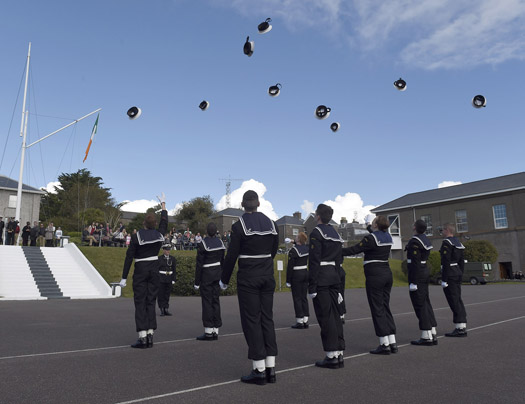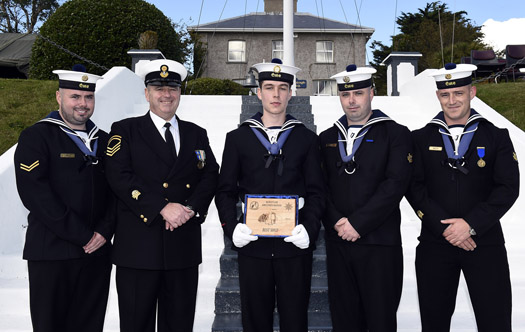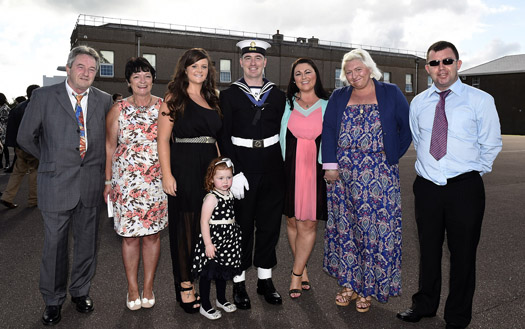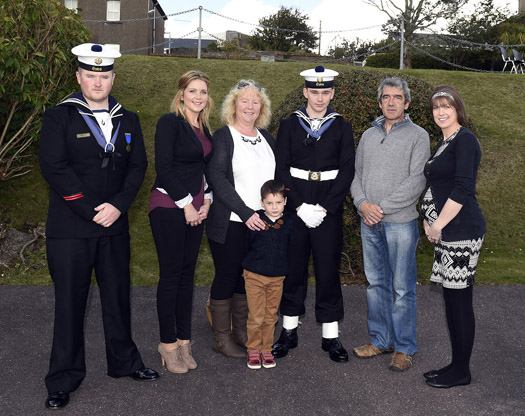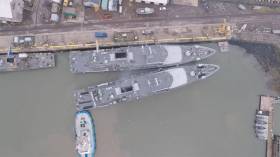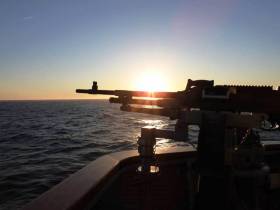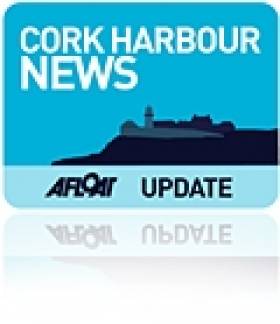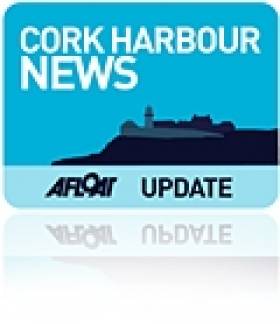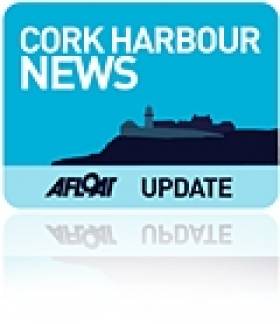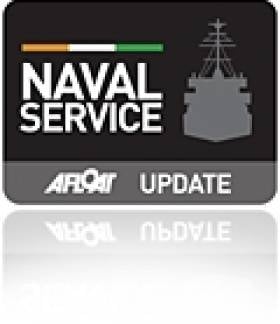Displaying items by tag: Haulbowline
Kinsale Yacht Club Cruising Group Enjoy BBQ and Overnight Stay at Naval Services Yacht Squadron at Haulbowline
Members of the Kinsale Yacht Club Cruising Group had a wonderful start to the cruising season with a BBQ and overnight stay at the Naval Services Yacht Squadron in Haulbowline Naval Base in Cork Harbour.
The event was organised by Niall and Bernadette McCann under the aegis of KYC Commodore Anthony Scannell and took place on the first weekend of May, and the weather was perfect for sailing: light SW winds, flat seas, and sunshine.
18 boats and their crews departed Kinsale before midday and began arriving at Haulbowline from 4.00 pm onwards. Despite the number of boats, everyone was impressed with the crew's skill in coming alongside so effortlessly. The Naval Services Yacht Squadron members were on hand to assist too.
After arriving safely, everyone made their way to the officers' mess where they enjoyed a most enjoyable BBQ and hospitality in the bar. The comradeship and laughter amongst everyone were evident, and they raised a glass to Sean Walsh, who was celebrating a significant birthday. It was the first cruising group sail in company.
 The Kinsale Yacht Club Cruising Group celebrated Sean Walsh's birthday (above) as part of its trip to the Naval Services Yacht Squadron at Haulbowline in Cork Harbour where they were entertained in the officers' mess (below)
The Kinsale Yacht Club Cruising Group celebrated Sean Walsh's birthday (above) as part of its trip to the Naval Services Yacht Squadron at Haulbowline in Cork Harbour where they were entertained in the officers' mess (below)



Neil and Felicity Prendeville began this event 20 years ago, and they participated this year, too. Captain William Roberts led the hospitality and welcome from the Naval Services Yacht Squadron.
The next morning, boats slowly departed, with the last boat leaving a little after 13.00. While the return journey was slightly uncomfortable due to an easterly wind and a lively sea, the highlight for some was spotting a group of at least 15 basking sharks off the Sovereigns.
All the boats and crew returned to Kinsale safely throughout the day. Everyone's positive feedback was much appreciated, and the group now looks forward to their next adventure: a picnic in Oysterhaven.
Bicentenary of Carlingford's Haulbowline Lighthouse Approaches
Lee Maginnis notes the 200th anniversary of the great granite Haulbowline Lighthouse on the County Louth coast will be in 2024
Haulbowline Lighthouse, that feat of granite engineering sitting on a wave-washed rock in the mouth of Carlingford Lough. Northern Ireland on one side, the Republic of Ireland on the other. Not that the nesting Cormorants on the window ledges know or care.
There was another lighthouse on Cranfield Point; it became a victim of the erosion going on a lot longer than many care to admit. But the old light had already been replaced by the time it fell into the sea.
It had been in the wrong place. Invisible to ships in the West and not marking the dangerous rocks at the mouth of the lough. George Haplin designed and built Haulbowline in 1824.
That makes the remarkable Haulbowline nearly 200 years old. Remarkable. Sitting out there on a rock that can rarely be seen. Battered by the waves. Strong currents racing past the base.
The tower was white until 1946. Now it is back to its natural stone.
Many other features have long gone. It seems a pity to many that they were not retained. The metal ball hoisted and lowered to indicate the tide level. The half-tide lantern displayed on the seaward side, halfway up. The red turning light. Explosive fog signals...
On 17 March 1965, Haulbowline had the dubious honour of becoming the first Irish major offshore light to be fully automated and remotely monitored and controlled from shore. The dataphonic system installed sent pre-recorded voice messages ashore by telephone about the status of the light and equipment. This was the beginning of the end of the lighthouse keeper.
 Haulbowline in the past. Photographer unknown
Haulbowline in the past. Photographer unknown
The fog signal sounded, and the light flashed if visibility was poor, day or night, back then.
The light still flashes three times every ten seconds. Still from a height of 32 metres in a tower 34 metres tall. But it is an LED now, range down to 10 nautical miles.
The fog signal is gone. It is missed by many.
Generators are no longer heard humming; now, a solar panel charges the batteries that provide power during the night.
Thankfully Haulbowline is still there and is listed. It is active. A monument to the past, but still capable of stirring up a strong sense of adventure and mystery today as it guides ships and guards the mouth of Carlingford Lough.
Kiwi Lee Maginnis lives in the countryside of Northern Ireland likes the outdoors, wildlife and sport. He has a keen interest in the sea and the environment.
Cork Harbour Upgrades for Navy's Spencer Jetty at Haulbowline are Underway
Remedial and strengthening works to the steel piles and concrete deck are underway at the Spencer Jetty at the Haulbowline Naval Base in Cork Harbour.
As Afloat reported last October, the upgrade at the Haulbowline Naval Base includes the construction of a raised turning area/parking zone and access ramp to the jetty.
The project provides for an investment of some €1.4m (excl VAT) to provide for the berthage needs at Haulbowline.
The plan is to stabilise the currently unusable Jetty structure and protect the sea entrance to the Naval Service Dockyard and Basin. The upgraded facility will also provide the Naval Service with an additional short term berth.
The project is part of the Plan to increase berthing capacity for the current fleet in three distinct standalone infrastructural projects, with the Spencer Jetty Upgrade delivered as Phase 1. All of these projects are included in the 5-year Infrastructure Development Plan.
When announced in October 2020, it was expected construction would take one year to complete.
The Government has assigned responsibility for the remediation of the former factory site on Haulbowline Island in Cork Harbour to the Department of Defence.
Minister Simon Coveney stated that with the successful remediation of the East Tip site into a 22-acre Public Park, the way is now clear for the remediation of the rest of the Island. The Minister paid tribute to the collaborative work carried out by Cork County Council and the Department of Agriculture, Food & Marine in turning the disused site into a public amenity, encompassing 4km of waterside paths and a 1km jogging circuit, complete with wildflowers areas and hundreds of new trees.
 Haulbowline Amenity Park includes 4km of harbour side walkways, a 1km jogging circuit and numerous seating areas to stop and take in the views of Cork Harbour. The park has also been extensively landscaped Photo: Cork County Council
Haulbowline Amenity Park includes 4km of harbour side walkways, a 1km jogging circuit and numerous seating areas to stop and take in the views of Cork Harbour. The park has also been extensively landscaped Photo: Cork County Council
 (Above and below) There are spectacular views of Cork Harbour from Haulbowline Island Photo: Bob Bateman
(Above and below) There are spectacular views of Cork Harbour from Haulbowline Island Photo: Bob Bateman
 Cobh as seen from Haulbowline Island Photo: Bob Bateman
Cobh as seen from Haulbowline Island Photo: Bob Bateman
The park has already become a significant community asset, which will continue to benefit the people of the harbour and environs into the future.
 The highly anticipated recreational area will be a welcome addition for the Cork Harbour region and in particular for residents of Ringaskiddy Photo: Bob Bateman
The highly anticipated recreational area will be a welcome addition for the Cork Harbour region and in particular for residents of Ringaskiddy Photo: Bob Bateman
The project was undertaken in partnership with the Department of Agriculture, Food and Marine in response to the need to remediate the East Tip. This remediation project was completed at a cost of €25m.
 (above and below) A nod to the Island's industrial past - the Blacksmith's hammer has been preserved on site Photo: Bob Bateman
(above and below) A nod to the Island's industrial past - the Blacksmith's hammer has been preserved on site Photo: Bob Bateman
The Minister emphasised that the continued participation of Cork County Council in overseeing the implementation of the remaining remediation works with his Department is crucial and welcomed the recognition that Government has given to the local authority’s expertise in this area.
 Haulbowline Amenity Park includes 4km of harbour-side walkways, a 1km jogging circuit Photo: Bob Bateman
Haulbowline Amenity Park includes 4km of harbour-side walkways, a 1km jogging circuit Photo: Bob Bateman
The Minister indicated that he has already had preliminary discussions with senior officials in Cork County Council on the way forward and is looking forward to working with them in completing the final remediation project.
Bob Bateman's photo gallery below shows views of Haulbowline Island during the initial remedial works
#Navy - The Naval Service has posted to its Facebook page a remarkable video captured by drone of the LÉ William Butler Yeats carefully berthing in its home port at Haulbowline in Cork Harbour.
The €66 million vessel, which was formally commissioned into service in October 2016, can be seen being slowly but surely positioned by a small but powerful tug alongside a sister ship — the two Naval Service vessels almost kissing at the bow.
LÉ William Butler Yeats is the third of three newly commissioned navy ships, after leadship LÉ Samuel Beckett and LÉ James Joyce, constructed by Babcock Marine Appledore in Devon, UK.
The ship spent much of 2017 on humanitarian patrol in the Mediterranean, where the Government has pledged to send two Naval Service ships this year as part of the EU’s mission to rescue migrants and reduce people-smuggling.
Why Has No Politician Expressed Concern In The Dáil About The 'Strategic Implications' Threatening The Naval Service?
Why has no politician of any hue, Government or Opposition, of any party or of the Independents, raised concern in the Dáil about the strategic implications for the State of the threat to a fully operational Naval Service and its joint operations with the Air Corps? Scroll down to listen to the podcast below.
Why has no one questioned the Taoiseach who, in the formation of the new Government, took to his own responsibility the Department of Defence, about these issues? The Department has stated, clearly and unambiguously, in public that Naval and Air Corps joint operations, including those directed towards marine counter-terrorism, replenishment of Naval vessels at sea and other operations, are under threat.
The Haulbowline Naval Base is “an important strategic location for the Irish Defence Forces..”
“It is the only Naval Service base in Ireland..” The threat to it “cannot be an acceptable situation for the necessary functioning of a fully operational Naval Base.”
Those are not my opinions. They are those of the Department of Defence.
And yet, they do not seem to worry the members of our National Parliament.
Not a mention in the Dáil, the assembly of the duly-elected representative of the people, no concern expressed about the “strategic implications” for the country’s Navy and Air Corps.
Either the politicians have no interest in the defence of the nation or they care little about the maritime defence force and its joint operations with the Air Corps.
I live in Cork Harbour and when I look out my kitchen window I see three wind turbines powering chemical factories close by and I can see the operations of several of these plants every day from my home, so I am well used to the heavy industrialisation of the harbour. However, this is an issue of the operations of the Navy and Air Corps, identified by the Department of Defence as having "strategic implications for the State" and which, as the Department has said, makes it a nationalo, not a local issue.
This week on THIS ISLAND NATION radio programme which you should listen to here, the Managing Director of the commercial company which is posing those identified threats to the Naval Service and Air Corps, tells me that the Services should “compromise” with the operations of his company, which will co-operate with them.
In my long years of journalism, half-a-century at this stage, I have never before heard any company suggest that the nation’s defence forces should have to compromise with a commercial operation, which is not a benign, beneficent public service but an international operation with a profit motive. I had presumed that the Defence Forces are vital to the structure of a democratic nation and should be considered above such pressure from commercial interests.
John Ahern, Managing Director of Indaver Ireland, whose incinerator proposed for Ringaskiddy, close to the Naval Base, has been described by the Department of Defence as posing those unacceptable strategic implications for the Navy and Air Corps, agreed to be interviewed by me on this specific issue. He had extended the invitation to interview him. In the course of it he expressed respect for the Navy, but told me that the State, in regard to his company’s proposals, had two tasks – management of waste and operation of the Naval Service. I expressed surprise that he equated the two and reminded him that, during an accident causing explosion and fire at the Indaver plant at Antwerp Port earlier this year, all those in the vicinity were told to “stay indoors.” Was he suggesting that the Navy would have to “stay indoors” in the event of an accident at his plant? There is only one road servicing the Naval Base on Haulbowline, which the proposed incinerator would be built alongside. He accepted that there is no guarantee against accidents, even though his company theoretically maintains that there would be none which would impact on the Navy and he indicated that it would be a matter for the Naval Service to decide its response if there was an accident. He said his company had suggested an alternative escape route through nearby premises of the National Maritime College/IMERC, though he also said that people in that area, just across the road from the proposed incinerator site, might have to be told to “stay indoors” in the event of an accident.
We did not agree, as I believe that the Naval Service should be of priority importance to the nation and its operations should not be subject to any threat from commercial interests and that there should be no strategic implications for it and the Air Corps, which has said that incinerator operations will cause a ‘no fly zone’ to be imposed over the Naval Base.
I was overly concerned with Naval Service operations, in his view.
I do not agree.
Mr. Ahern appeared confident of gaining approval from Bord Pleanala, the national planning board, to proceed with the incinerator construction after a public hearing which has concluded and a decision is awaited.
Can it be that this Board, unaccountable to anyone, now has the power to decide on future Naval Service and Air Corps operations?
Can this be acceptable in an independent nation, that a planning board and not the Government, should have the power to decide on the future operations of Defence Forces?
Also on the programme, the President of the Nautical Institute, the world representative organisation for professional seafarers, says that Ireland needs a strong maritime voice. I agree with this view expressed by Captain Robert McCabe
Regrettably, it seems that a strong voice of concern about the “strategic implications” for the “fully operational” maritime defence force, the Naval Service and it Air Corps operational partners, is not present in Dáil Eireann.
Listen to the podcast below.
#haulbowline – The toxic site at Haulbowline in Cork Harbour looks set to be cleaned up following a Government decision to allocate a total budget for the island remediation project of €61m.
Commenting at the decision, the Minister for Agriculture, Food and the Marine, Simon Coveney TD said "I welcome the approval of this very significant €61m in funding to take a "whole of island" approach to the remediation of Haulbowline Island. We have already seen An Bord Pleanála and the EPA give approval for the remediation project and the completion of crucial work to repair the Haulbowline Island access Bridges. While analysis, testing, design and enabling works have been continuing we can now look forward to the core remediation work at Haulbowline Island including remediation of the East Tip, former steelworks factory site and south tip".
In 2011, As Afloat reported, Europe gave a deadline of three months to 'clean up' the site. Earlier this year, there was speculation the cleaned up site could be a future hub for international yachting.
The Minister went on to say "The next phase of the project, following the agreement of my Cabinet colleagues, is the most complex phase to date and is expected to take approximately six months to complete, following the appointment of Consultants. This will lead to commencement of initial elements of the core remediation 'clean-up' phase on site, by late 2015. This work will intensify into 2016 and 2017 with significant progress towards completion of the project expected by late 2017. There will be significant construction activity on the island, it will bring substantial benefits to the local economy and transform the Island into a genuine national infrastructural asset. "
The Government approved a proposal to enable the clean-up of the East Tip on Haulbowline Island in 2011. Cork County Council is acting as agent of the Minister in the remediation of the site. Key milestones of the remediation project were the planning application for works on the East Tip, lodged with An Bord Pleanála in October 2013 and the waste licence application, submitted to the Environmental Protection Agency in November 2013. The approval of both planning and waste licence applications which involved complex and detailed preparatory work cleared the way for the completion of the project in the East Tip. Today the Government has agreed a total budget of €61m for the remediation of all areas of the island (East Tip, South Tip and former steelworks site) and not just the East Tip which is the focus of an ECJ judgement.
Haulbowline Island is located within Cork Harbour, between Cobh to the north and Ringaskiddy to the south. The East Tip contains approximately 650,000m3 of steelworks waste that was deposited on a sand spit over a 40 year period. The demolition of the former steelworks has also left a large site in the centre of the island that is unusable pending remediation. Access to the Island by road is from Ringaskiddy via bridges which transverse Rocky Island.
#CorkHarbour - Marine Minister Simon Coveney last Friday (1 May) officially re-opened the newly remediated Haulbowline Island Bridges at Cork Harbour.
The bridges have undergone extensive repairs and upgrades as part of the early preparatory phase of the Haulbowline Island Remediation Project.
This long-delayed project is set to transform the former Ispat/Irish Steel site on the island into a major public amenity area.
When completed, it will also provide a potential future development location for the Naval Service, which is headquartered on the island.
It is not yet known, however, whether future plans for the island will also include an 'Ocean Racing Yacht Hub' within the Naval Service base.
Reopening of the bridges, which represents the sole land-based road access point to the island, allows for the core remediation of the island's East Tip and the former factory site to proceed later in 2015 – a year after the EPA granted the necessary waste licence.
"The completion of this significant piece of infrastructural work, apart from being a major engineering achievement in its own right, paves the way for the long awaited core remediation work to proceed," said Minister Coveney.
"Once completed this project will usher in an entirely new phase of this island’s long and distinguished history and represents tangible evidence of the Government’s commitment to Cork Harbour and to the wider marine sector."
The minister commented Cork County Council, consultants RPS Consulting Engineers and contractors LM Keating Ltd for carrying out the work within a relatively tight timeframe and within budget.
He also paid tribute to the Naval Service for facilitating the refurbishment and for ensuring that its day-to-day work was not impacted throughout the busy construction phase.
The upgrade was financed as part of a €40 million package signed off in October 2011 to clean up the toxic waste site at the former steelworks. Full details of the planned work are available at www.corkcoco.ie.
#haulbowline – Marine minister Simon Coveney says there has been no final decision taken on an 'Ocean Yacht Racing Hub' within the Naval Service base at Haulbowline island in Cork Harbour.
In this morning's Irish Times newspaper, marine correspondent Lorna Siggins writes that a British yacht racing consultancy has met Government agencies as part of a 'grand plan' for haulbowline island, site of a former steelworks site. The plan for the yacht base was first mooted by British solo racer Alex Thomson when he called into to Cork Harbour for repairs last April before heading across the Atlantic Ocean.
As Afloat.ie reported last October, Thomson, together with his shore manager Stuart Hosford, a Cork native, returned to the harbour and gave a public lecture about his solo sailing success that also included comment about the potential to develop the harbour site. The visit was part of an 'Innovation Week' in Cork where Cork Institute of Technology, the Irish Naval Service and University College Cork promoted the first Imerc Innovation Week.
Interest in the Haulbowline site focuses on the substantial graving dock where large yachts measuring up to over 100–foot in length or more could be lifted in an out of the water in a deep water environment with convenient access to the Atlantic.
Haulbowline has been making headlines for years because of cancer-causing residue, left over from the Irish Steel plant that once occupied the land. It has been confirmed that a cache of 500,000 tonnes of slag and toxic waste material were buried at the former steelworks. Afloat reported on the hot site in the harbour in 2011.
More in the Irish Times on the Yacht Hub story here.
Naval Service Reserve Passing Out Ceremony At Haulbowline
#navy – Ten new recruits to the Naval Service Reserve completed their training in a ceremony in the Naval Base on Haulbowline yesterday. The 10 recruits, 9 from Cork and 1 from Dublin endured 3 weeks of intense training where they covered a range of subjects such as foot and arms drill, marksmanship, sea survival, fire-fighting, military law and an introduction to military customs, traditions and way of life.
This is a milestone as it marks the first integrated Naval Service Reserve recruit class since the inception of the Single Force Concept which is a key element of the 2012 Defence Forces Reorganisation. The training was shared between members Naval College and the Naval Service Reserve. The Naval Service Reserve will soon be seeking a total of 25 potential recruits in its Cork (2), Dublin (5), Limerick (8) and Waterford (10) units.
The role of the NSR is to augment Naval Service seagoing strength through provision of trained personnel whilst at unit level providing the capability for an armed Naval Element afloat with local shore support and expert local maritime knowledge and intelligence in support of PDF Operations at and from the sea in the main trading ports in support of maintenance of National Sea Lines of Communication (SLOC).
The Naval Service is an integral part of Óglaigh na hÉireann / Defence Forces and operates jointly with the Army and Air Corps. The Naval Service protects Ireland's interests at and from the sea. Currently, the Naval Service is tasked with a broad range of maritime defence, security and other roles. Routine patrols are multi-tasked to encompass national and maritime security, ocean governance, fishery protection, safety and surveillance, port security, drug interdiction, pollution control and search and rescue.
The Service also supports Army operations in the littoral and by sea lift. It provides support on Aid to the Civil Power and Aid to the Civil Authority operations, including inter alia maritime security cordons, and possesses the primary diving team in the State. The Fisheries Monitoring Centre ( FMC) at the Naval Base is the designated national centre with responsibility for monitoring all fishing activity within the Irish Exclusive Fishery Limits and all Irish fishing vessels operating around the world. In addition, Naval Service Vessels have undertaken supply and reconnaissance missions to overseas peace support operations and participated in foreign visits in support of Irish Trade and Diplomacy.
